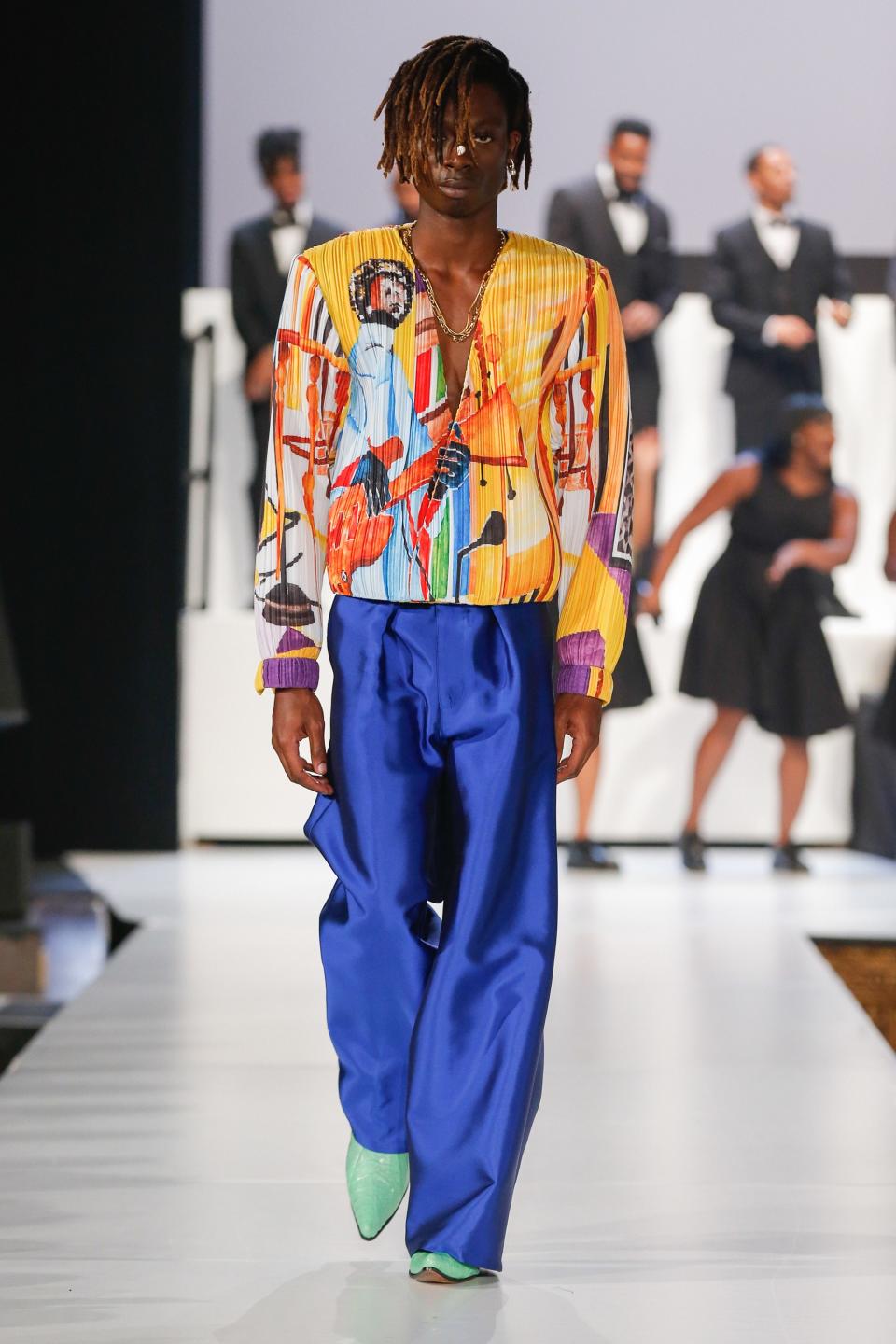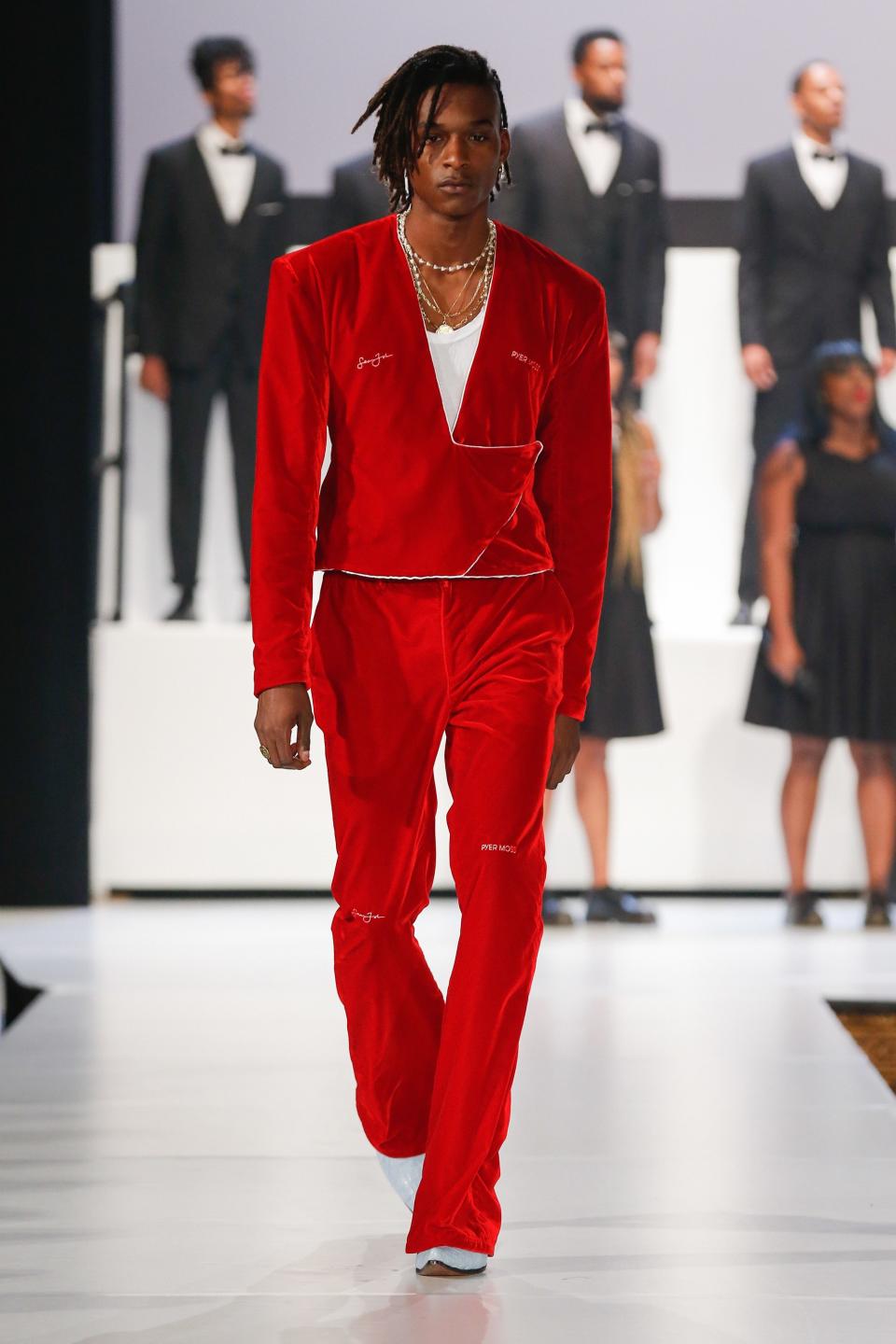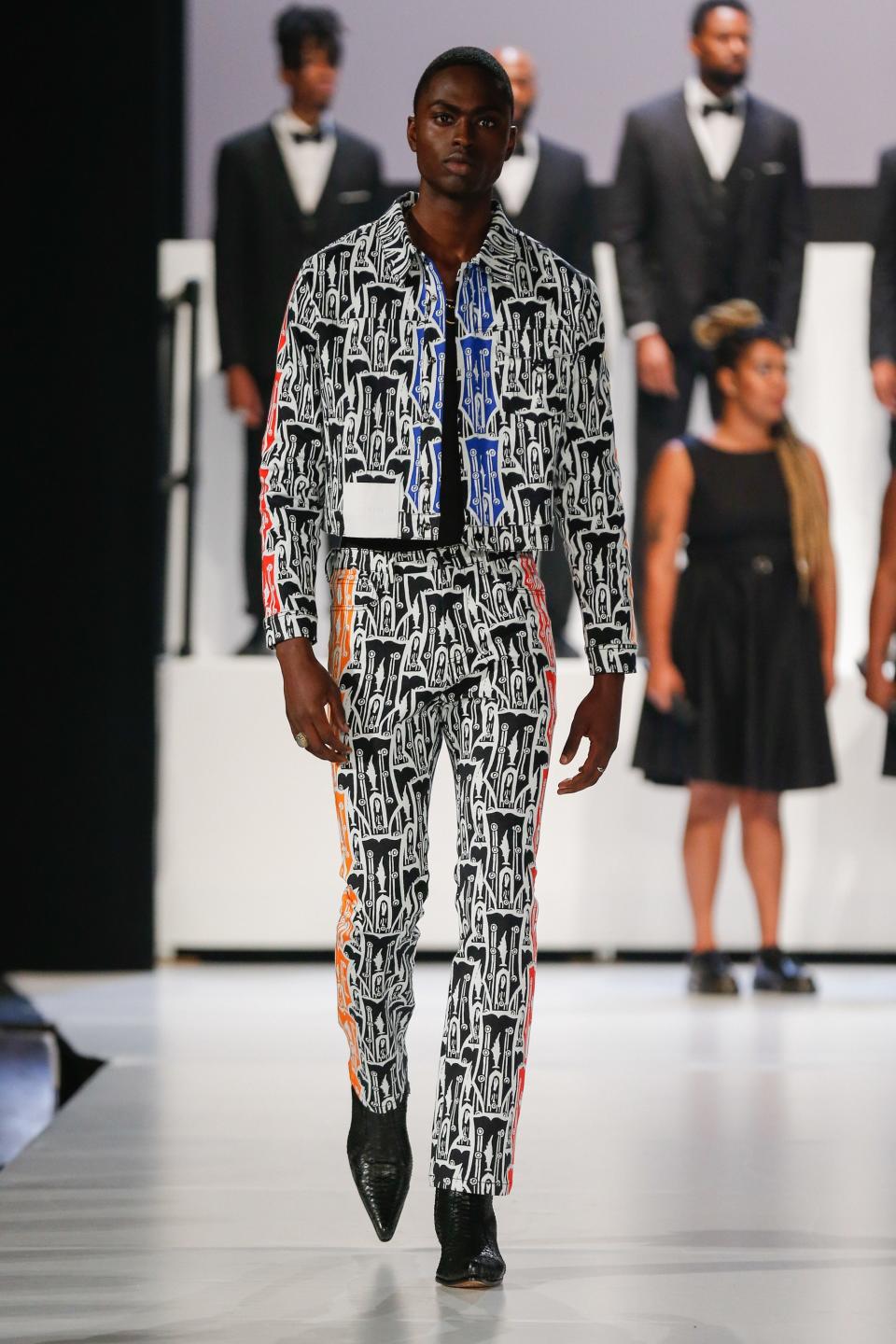Pyer Moss Designer Kerby Jean-Raymond on the CFDA, His New Collection, and Finally Making It
“Slowly but surely, I’ve been bringing fashion to me as opposed to going to fashion,” the Pyer Moss designer Kerby Jean-Raymond said on Saturday afternoon. “And this is kind of a really, really pivotal moment for me because I somehow ended up with the biggest show [in New York], apparently, is what people are saying. People are stopping me in the street. Somehow, everybody, 3000 people apparently, back to my neighborhood instead of—” Jean-Raymond stopped. “Excuse me.”
Swizz Beatz was calling: “Heyyy, man!”
It was about 30 hours before Jean-Raymond’s latest runway show, which would would bring thousands of people—fashion industry members as well as fans who signed up for free tickets back in August—to Kings Theatre in Flatbush, Brooklyn, where Jean-Raymond grew up. He was planning a spectacle that would outdo even last September’s highly emotional show, at Crown Heights’s Weeksville Heritage Center, the site of one of the 19th century’s first free black communities. Its message-driven clothing, powerful portrait of everyday black life, and choir (a Pyer Moss staple since his early days; he launched the brand in 2013) had been a defining mood of Spring 2019; many critics are still talking about it as one of the best shows of the season. When Jean-Raymond decided to sit out February’s New York Fashion Week, announcing he’d only be showing “when I want,” that seemed only to build up anticipation for Sunday’s show rather than diffuse the hype.


Jean-Raymond is a straight-shooter with big ideas, but like many of his generation’s biggest designers, his ideas are less ambitious fashion fantasies than solutions to problems, whether it’s the political issues like the climate crisis and race, or more prosaic stuff like what sneaker to pair with a trackpant. He’s often described as one of fashion’s most outspoken designers, though it’s more that he’s 32 and doesn’t subscribe to the PR cushioning that shaped the preceding generation. He generally keeps a cool head, though it seemed this weekend was testing him, and his young team—the Pyer Moss family—in particular. In the middle of final fittings, he started to head out for 30 minutes to get a haircut, but in the elevator, the chaos upstairs made him think better of it. “I can’t let my shit get messed up,” he said. So we went back to the studio—a large loft in Chelsea borrowed for the fittings—and he put things into a systematic flow. “Wait and see,” his longtime stylist Eric McNeal teased me as we gazed at a model in a fitted trumpet skirt that was gaping at the waist. “We’re going to work magic tomorrow night.” Order regained, we sat down to catch up. Since I profiled him last winter, he’d signed a new deal with Reebok, been named to the CFDA board, and managed to build on his buzz despite stepping back. What is he planning to do now that he has, in his words, “made it?”
Swizz said goodbye, and Jean-Raymond picked up right where we left off. “It seemed like the only way to get success in this space was to have Kanye co-sign, or Rihanna co-sign, or whatever celebrity was trending at the time,” Jean-Raymond said. “I think the first four years I came out, I was trying to chase that formula and trying to make that formula work. The minute I decided that it’s not going to work, it’s not for me, and I really just do the things that I’m passionate about and show that in my work, everything changed.” Three years ago, for example, he was showing at Milk Studios in Chelsea and juggling investors. Now, he owns his company and gets the industry to come to Crown Heights and Flatbush. It’s meant the difference between trying to seed product to influencers or celebrities “versus opening the Shopify and seeing that Michelle Obama made a couple-thousand-dollar purchase.”

A lot has changed in a year, both for the industry and the designer. He asked me, “Do you think that our brand was the brand that was the catalyst for all these brands now trying to have a conscience and a heart?” I told him I’d planned to ask him the same question. He doesn’t want to sound narcissistic or cocky, he said, but “I see pieces of this art being replicated in places,” adding that, for example, “somebody else, who does not need to be named, does the choir thing every Sunday.” You’d think it wouldn’t be the worst thing in the world for fashion brands to feel more spiritual, and more aware of political and social crises, but, “If you’re going to copy my shit, copy my philanthropy too. Don’t just half-ass it. Don’t take it and sell a T-shirt. Take it and move a mountain.”
The most recent change in Jean-Raymond’s world is the announcement last week that he will join the board of the Council of Fashion Designers of America, after Tom Ford appointed him along with Virgil Abloh, Maria Cornejo, and Carly Cushnie. “I think that the CFDA is moving in the right direction by acknowledging that there’s a diversity, inclusion, and race problem in American fashion,” he said carefully. “Selecting me on the board of directors”—he paused—“is cute. I’m honored that I was chosen. I would’ve been offended if I wasn’t. However, I do feel like I have to wait and see what my role is. It was under conspicuous timing when I received that letter,” he said, referring to the period when protests began around board member Kara Ross, the wife of Hudson Yards developer and Donald Trump supporter Stephen Ross. (Ford told WWD last week that Ross’s departure “has absolutely nothing to do with her political views or her [husband’s] fundraiser for Trump.”)
Jean-Raymond continued, “I think an organization like the CFDA that is meant to be progressive and to be supportive of young artistic talent—which tends to be gay, which tends to be poor, which tends to be ’other’—should’ve known better, and done a better vetting process than to employ—I mean, than to adorn someone associated, married to a person with such a low moral fiber.


“Am I going to regret saying this? Probably. Depends on how you write it. But I do think that the CFDA pulling me in—I have to wait and see what I can actually do as a board member. I don’t know what my power and my role is.” Jean-Raymond seemed optimistic about the CFDA’s potential to enact real change, though, suggesting programs that would provide money for young designers who need help in producing shows and clothing, scaling their business, and honing a more commercial vision to balance their creative instincts. “Let’s catapult these motherfuckers, these young kids that’s crushing it, who can out-design me in their sleep,” he said. “Where’s their platform? Where’s their launching pad?”
Jean-Raymond himself has a new platform through his expanded role at Reebok, the sportswear giant he’s partnered with since 2017. Well, two new platforms, he corrected me: “I’m starting a company with Francois Pinault,” the head of the Paris-based fashion conglomerate Kering. “It’s a collective. It’s an accelerator for brands. I came up with the idea, ran it by [co-founder, president, and chief brand officer of Away] Jen Rubio; she was down.” He deadpans: “My two billionaire best friends.”

That’s all he’d say on that, but at Reebok, he’s extended his own contract, under which he creates sneakers and apparel, and is now the artistic director of a new program called Reebok Studies ___, for which he’ll create special projects in collaboration with designers and celebrities. “We’re in the process of signing young designers now,” he said, mentioning that the first project will launch next year. “It’s hard though; getting people to come over to Adidas and Reebok without being tempted with Nike checks is not the easiest thing in the world. And the thing about a company like Nike—and no offense to nobody who took a Nike deal—but I couldn’t do a deal where I couldn’t get royalties and I couldn’t eat off of my designs and gratuity. That, for me, doesn’t work. I decided to go another way.”
In addition to his Reebok sneakers, he’s also made his own silhouette for the season, a webby slip-on with a loud, boat-like sole (it looks like the Raf Simons Ozweego wandered out of the proverbial art gallery). “I wanted a really polarizing silhouette,” he said. “I wanted a shoe that was going to be offensive to look at.” It will sell for about $800, he said. He has shifted to a see-now, buy-soon model, so that the first drop of the collection shown Sunday night will be available October 15th, with the sneakers arriving in January.



He’s also won the CFDA Vogue FF prize, which brought with it a new relationship with Vogue editor Anna Wintour. They still keep up—Wintour is known for advising young designers—but he said, “It’s not really advice. It’s more like [a] pulse check: How you doing?” He added, “Me and Anna, we fuck with each other. We’re both Scorpios.”
Jean-Raymond told me he had actually been working on this particular show since August 2018, combining the artwork of Richard Phillips, who was wrongfully imprisoned for murder for 45 years, with the story of Sister Rosetta Tharpe, rock n’ roll’s underrecognized godmother. He waited until now because of the money: “I just got my new contract, so I was going to invest a little bit more in this and I wanted to make sure [Phillips] was done right financially at least. He named his price. We paid it. It was not even about the money at all. I don’t want that to be a factor just a matter of this dude is special and I wanted to treat him special and I wanted to be sure that we were ready for him.”
The collection had silhouettes and motifs inspired by Sister Rosetta, including a number of pieces featuring Phillips’s painting of Tharpe, such as a denim print made by Resonance, a New York-based company that can print denim without the tens of thousands of gallons of water usually used in the process. The menswear silhouette, he said, is what he really feels he’s perfected for this season: “a very triangular upper, wide leg, slight bell, high waist. It’s a very modern version of a zoot suit.” He still feels his menswear is in a better place than his women’s. “I wouldn’t say this is the season we’ll nail it for women,” he said, “but definitely by next season.”


The next night at Kings Theatre was absolute chaos—like the wild scene in the studio times 1,000. It was nearly impossible to get in, the show started almost 90 minutes late, and a number of people were assigned duplicate seats. And then Jean-Raymond pulled it all off. Quavo, Saweetie, Joey Badass, Kehlani, Justine Skye, Slick Woods were in the front row; Kitty Cash had to squeeze herself into the second. The choir—“The Pyer Moss Tabernacle Drip Choir Drenched in The Blood”—was bigger than ever and sang a mix of gospel, Missy Elliott, and Cardi B. People cheered for the clothing, which doesn’t happen at Fashion Week. A number of attendees were in tears by the show’s end. A collaboration with Puff Daddy’s Sean John created an instant buzz both in the room and for those watching online. Puff “reached out after I won a CFDA award,” Jean-Raymond had told me Saturday, “and was like ‘Keep doing your thing king. I’m proud of you, king.’ And I was like, That’s it! Let’s do Sean John.”
Those collaborations have been a part of this three-chapter narrative, called America, Also—he worked with Cross Colours on Collection 1 (Fall 2018), and Fubu on Collection 2 (Spring 2019). But this collection would be the last one in the series. “Fubu, Cross Colours, and Sean John fit with America, Also because it’s all about reteaching yourself, and reversing a racial lesson in the first place,” he said, “Now when we move into the next thesis, for Collection 4, we have to see what brands make sense with that.”
If Collection 3 was the final piece in an exploration of what black designers might do if they had the resources, power, and marketing mystique typical of white-owned fashion brands, the next phase will be about relaxing into this new power, “to reach down, or reach vertical, instead of reaching back.” He told me the name of the next chapter. But he asked me not to print it—he jokes that he doesn’t want that guy, the one who doesn’t need to be named, to steal it.

Originally Appeared on GQ

